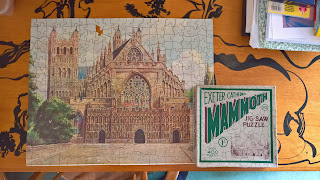A few weeks ago I was given a heritage jigsaw, probably dating from the 1950's, and over the past few days I have been doing it, revisiting (and perhaps reviving) a hobby which expired just about four years ago, with the last recorded puzzle being noticed at reference 1.
Sold from its charity shop as having two pieces missing, positions thoughtfully marked on the picture on the box, but which turned out to have just one piece missing. Perhaps someone had cut out a replacement piece, not something I would attempt myself, partly because it would take up too much quality time, partly because I don't think that I would make a very good job of it. Not even very sure how exactly I would go about it in the absence of a range of suitable gouges with which to do the cutting.
One feature of this puzzle was the absence of a proper picture of the completed puzzle, just the rather crude line drawing of it on the front of the box. So one had no ready made clues about colour. On the other hand, it was a painting rather than a photograph, which I have always found a lot easier. But a painting which does something odd with the second tier of the west front, the bit with the large window. Something odd which makes the two flanking walls with crenellations look as if they are angled side walls, when actually the whole thing is flat, in the plane of the puzzle, just a few feet back from the first tier, the tier with the three front doors.
Given that there were lots of long, straight cuts in the interior of the puzzle, it was not easy to separate out the edge pieces, so I did not proceed by assembling the edge of the puzzle, which, as I recall, was my usual line of attack. Rather, I started by assembling the sky line of the cathedral and then worked down.
Lots of long, straight cuts also meant that the growing jigsaw was very fragile, not all nicely tied in together in the way of a modern jigsaw, in which most pieces have three or four of the four sides tied in. All too easy to sweep a chunk off the table onto the floor with one's cardigan or elbow.
On the other hand, lots of pieces had acutely pointed corners of distinctive shape, which made them relatively easy to pick out of the heap. Except when they were so narrow and fragile that they had broken off, so one could spend some minutes looking for a non-existent piece.
At some point, I noticed the narrow white stripe at the bottom of the puzzle, which meant that I could, after all, quite easily sort out the bottom of the puzzle and start working up.
Sky last, but small enough in terms of the number of pieces involved, not to be the long-winded affair it can sometimes be. Only modest recourse to sorting the remaining pieces by type.
Maybe half a day in time, spread over three days. About the right time for me: it absorbed me for a while - and then I finished it before I got bored.
PS: the pastry cutter like dies used to cut jigsaws are usually made with long thin strips of metal, one of the two edges sharpened for cutting, laid one way, connected up with a lot more short strips running the other way, all pegged down to a piece of thick wooden board and together amounting to a more or less rectangular grid. Having taken a good look, I would not care to say whether the long strips were vertical or horizontal, but readers, if they were to click to enlarge, might take a view.
Reference 1: https://psmv2.blogspot.com/2014/11/jigsaw-9-series-3.html.

No comments:
Post a Comment